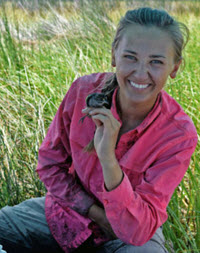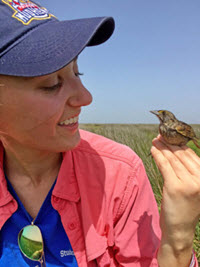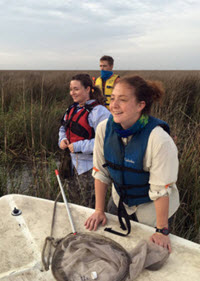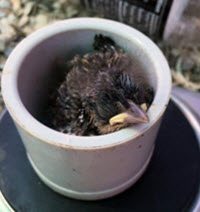
Allison holds a Seaside Sparrow after a muddy day in the field. (Photo credit: Anna Perez-Umphrey)
Seaside Sparrows live and forage in coastal Gulf of Mexico marshlands, some of which were oiled following the Deepwater Horizon incident. Sparrows in these oiled marshes likely ingested invertebrates that were also exposed to oil. Allison Snider uses DNA analyses to investigate potential long-term changes in the diets of Seaside Sparrows following Deepwater Horizon. She hopes that her findings will provide insight into the resilience of these birds and their environment following a large-scale disturbance such as an oil spill.
Allison is a wildlife biology master’s student with Louisiana State University’s School of Renewable Natural Resources and a GoMRI Scholar with the Coastal Waters Consortium (CWC).
Her Path
Allison’s parents fueled her passion for science by giving her nature field guides, conducting experiments with her in their kitchen, and helping her grow flowers and vegetables. She enjoyed learning about different ecosystems during visits to science museums, zoos, and state parks. When she entered Central Michigan University as a freshman, she found herself torn between her two favorite subjects, English and science. However, exciting fieldwork opportunities and the potential to learn more about the natural world in the science field persuaded her, and she completed a bachelor’s degree in natural resource biology and a minor in museum studies.
Allison wasn’t sure what she wanted to do after graduation until she discovered an open position with Dr. Sabrina Taylor at Louisiana State University. Taylor and her colleague Dr. Phil Stouffer were seeking a graduate student for their CWC project researching the Deepwater Horizon incidents effects on marsh Seaside Sparrows. “I was drawn in by the unique research and how it focuses on the implications of interactions between nature and society,” explained Allison. “It is crucial to learn from our mistakes, and that’s why this is research topic is so important to me – it offers a way to make the best of a bad situation.”
Her Work

Allison checks a Seaside Sparrow after processing, which includes measuring the tarsus, wing, and tail, checking for a brood patch or cloacal protuberance, and collecting various types of data. (Photo credit: Anna Perez-Umphrey)
Allison studies the diet of Seaside Sparrows to determine if the oil may have altered the saltmarsh food web. Allison extracts DNA from gizzard, fecal, and ligature samples collected from the sparrows during 2011-2017. Then she analyzes them using metabarcoding to target a short DNA region common to many different organisms called the cytochrome C oxidase subunit I or COI. Because the technique uses a common DNA region, she is able to analyze many prey species in a single sample at the same time.
She identifies the COI region of each prey found in a dietary sample and amplifies it to identify small differences in their genetic sequences, which she compares to online sequence databases and identifies the prey’s exact species. Once she completes the DNA analysis and prey identification, Allison will use this information to compare the dietary compositions of birds in oiled and unoiled saltmarshes and identify differences between their long-term dietary habits.
“What is so exciting to me about my research and about the Gulf overall is that I get to dive into this big, complicated system and try to understand the place of a single species in the bigger picture,” said Allison. “I am humbled to study an important system that people all along the Gulf Coast rely on.”
Her Learning

Allison snapped this photo of (front to back) Anna Perez-Umphrey, Megan Hart, and Tyler Williams watching dolphins as they hunted close to shore. (Photo credit: Allison Snider)
Many of Allison’s most memorable moments during her research experience occurred while working in the field. The long days and deep concentration often required for successful fieldwork can be exhausting. However, Allison found that encountering unexpected animals in the marsh and bay helped her see the big picture. She recalled that early one morning, a pod of dolphins began hunting a few meters from the marsh edge just as she and her team members pulled their boat ashore. “The entire crew stood completely still. I turned away from the dolphins for just a moment to see if my friends were watching the frenzy,” recalled Allison. “Seeing the looks of wonder and amazement on their faces was incredible, and I think it really is the heart of why we’re doing the research that we’re doing.”
Allison believes that these types of experiences helped her realize that science is not an isolated practice but something that occurs across academic disciplines for the benefit of all. “No matter our backgrounds, we’re united by a drive to see how we can learn from the Deepwater Horizon disaster and move forward in a constructive way,” she said. “It’s a privilege to work alongside my colleagues and all of the scientists in the GoMRI program.”
Her Future

Allison weighs a Seaside Sparrow nestling. (Photo credit: Allison Snider)
Allison hopes to find a position with a state department where she can apply her research in a policy-focused role. She suggests that students considering a scientific career not worry about following one specific path, as there is no one “right” way to enter a scientific field. “One of the great things about my graduate work has been meeting people with a variety of backgrounds and experiences,” she said. “Don’t compare yourself to others, because everyone has different starting points and end goals. Learn from the diversity, appreciate it, but don’t hold yourself to someone else’s path.”
Praise for Allison
Dr. Taylor described Allison as a gifted writer and bright researcher who brings good ideas and a positive attitude to her research lab. “I’m very much looking forward to seeing the results of her research,” said Taylor. “They will certainly provide a deeper understanding of the effects of the oil spill.”
The GoMRI community embraces bright and dedicated students like Allison and their important contributions. The GoMRI Scholars Program recognizes graduate students whose work focuses on GoMRI-funded projects and builds community for the next generation of ocean science professionals. Visit the CWC website to learn more about their work.
************
The Gulf of Mexico Research Initiative (GoMRI) is a 10-year independent research program established to study the effect, and the potential associated impact, of hydrocarbon releases on the environment and public health, as well as to develop improved spill mitigation, oil detection, characterization and remediation technologies. An independent and academic 20-member Research Board makes the funding and research direction decisions to ensure the intellectual quality, effectiveness and academic independence of the GoMRI research. All research data, findings and publications will be made publicly available. The program was established through a $500 million financial commitment from BP. For more information, visit http://gulfresearchinitiative.org/.
© Copyright 2010- 2017 Gulf of Mexico Research Initiative (GoMRI) – All Rights Reserved. Redistribution is encouraged with acknowledgement to the Gulf of Mexico Research Initiative (GoMRI). Please credit images and/or videos as done in each article. Questions? Contact web-content editor Nilde “Maggie” Dannreuther, Northern Gulf Institute, Mississippi State University (maggied@ngi.msstate.edu).
